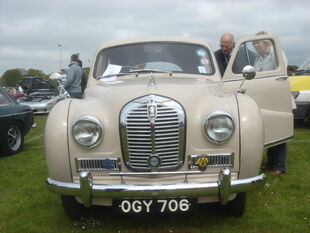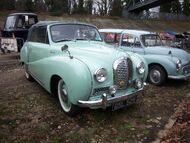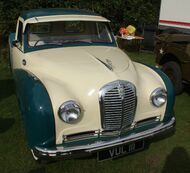
1953 Austin A40 Somerset
The A40 Somerset is an automobile sold by the Austin Motor Company from 1952 until 1954. It replaced the A40 Devon and was quite similar to that body-on-frame car, including using the same 1.2 L straight-4 pushrod engine. The engine was updated to produce 42 hp (31 kW), however giving the car a top speed of 69 mph (111 km/h).
The Somerset featured an updated "Transatlantic" body style designed for export and resembled the larger A70 Hereford. It had a bench front seat and column mounted gear change. The Somerset was initially only a 4-door saloon, though a 3-passenger 2-door convertible model made by Carbodies of Coventry was also sold later. The 2-door and convertible differed from the 4-door cars in having separate front seats that folded forwards to give access to the rear. The Austin Motor Company in 1953 made a "special" version of around 500 Somerset saloons with a more powerful engine, different interior appointments and two tone paintwork. The Austin Somerset special had a top speed of 74 mph (119 km/h) while the normal saloon could reach up to 70 mph (110 km/h).
Over 173,000 were sold before the Somerset was replaced by the A40 Cambridge in 1954. 7243 of them were convertibles.
Performance[]
A convertible version tested by The Motor magazine in 1953 had a top speed of 74 mph (119 km/h) and could accelerate from 0-60 mph (97 km/h) in 28.6 seconds. A fuel consumption of 30.1 miles per imperial gallon (9.38 L/100 km; 25.1 mpg-US) was recorded. The test car cost £705 including taxes. These figures were all obtained on the contemporary low octane fuel.
The Austin A40 Somerset has a reputation for being somewhat slow and lumbering to drive, and not wholly deserved.
The first A40 Somerset had to endure Pool quality petrol supplies (1952) and in consequence had retarded ignition settings to tolerate the low octane rating of this poor fuel grade to avoid the 'pinking' condition that was well known in those times.
In fact BMC later produced a kit to improve the performance and fuel consumption of these cars once premium fuel supplies resumed under the popular petrol brands. This kit comprised a replacement distributor and an optional head gasket for the cylinder head that was thinner and therefore raised the compression slightly from the standard 7.2:1.
The Autocar Road Test published 18 April 1952 achieved a maximum of 66 mph (106 km/h) (mean) and 71 mph (114 km/h) (best), and a 0-60 mph acceleration of 36.6 seconds whereas the example registered new in February 1954 and given a Used Car Test published in the Autocar series dated 8 April 1960 returned a 0-60 mph time of just 27.9 seconds. The standing quarter mile was down from 24.4 secs to 23.2 secs a marked improvement on the former result taken in 1952 and directly comparable with the Mini 850 launched in 1959, that was considered to be fairly brisk then.





